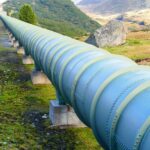Water cycle management best practices explained
Water cycle management best practices, Ecological Consequences, etc
The Great Basin’s Thirsty Story: Water, Climate, and Our Future
A Vast and Arid Landscape
The Great Basin, a vast region encompassing portions of Nevada, Utah, California, Oregon, Idaho, and Wyoming, is known for its dramatic landscapes and stark beauty. However, this region also faces a critical challenge: severe water shortages. This dryness is not a new phenomenon, but the situation is worsening due to climate change, increasing population, and unsustainable water use practices.
A Thirsty Future
Climate change is causing drier conditions, with less snowfall and more evaporation. This leads to reduced snowpack, the primary source of water for the region, and declining groundwater levels. Meanwhile, the population of the Great Basin is growing, putting increasing pressure on already strained water resources.
Urgent Need for Solutions
To address this crisis, we need to find sustainable solutions. We must focus on three key areas:
- Water Conservation: Implementing water-saving measures in homes, businesses, and agriculture is essential. This includes adopting technologies like water-efficient appliances and irrigation systems, as well as changing our personal habits.
- Effective Water Resource Management: We need to improve the way we manage our water resources, ensuring that they are allocated fairly and efficiently. This includes investing in infrastructure, improving water storage, and implementing water rights policies that promote sustainability.
- Innovation and Sustainability: We need to explore innovative ways to use water more sustainably. This could involve developing drought-resistant crops, exploring desalination technologies, and promoting water reuse programs.
The Active Climate Rescue Initiative: A Beacon of Hope
The Active Climate Rescue Initiative is leading the way in tackling this challenge. Their work focuses on developing and implementing solutions for water conservation, resource management, and sustainability. Through their research, outreach programs, and partnerships, they are empowering communities to make a positive impact on the future of the Great Basin.
Action Needed: Water Your Lawn Less
Even small changes can make a difference. Consider these simple steps:
- Use a timer: Water your lawn only when it needs it, avoiding wasteful overwatering.
- Choose water-wise plants: Opt for plants that are naturally adapted to the dry climate, requiring less water.
By taking action, we can help ensure a sustainable future for the Great Basin, preserving its unique beauty and the vital resources it provides.
The Great Basin’s Thirsty Story: Water, Climate, and Our Future
TL;DR: The Great Basin is a vast area in the western United States that faces severe water shortages. Climate change is making the problem worse, and we need to find ways to conserve water and use it wisely.
H2: A Land of Limited Water
The Great Basin is a huge region that covers parts of Nevada, Utah, California, Oregon, Idaho, and Wyoming. It’s known for its dry climate, mountains, and deserts. The Great Basin gets most of its water from snow that falls in the mountains during winter. This snow melts in the spring and summer, feeding rivers, streams, and underground sources of water called aquifers.
H2: The Water Cycle’s Journey
The Great Basin’s water cycle is a bit different than other places. Because it’s surrounded by mountains, the water doesn’t easily flow out. It evaporates from the ground, lakes, and rivers and returns to the atmosphere, or it seeps underground.
H3: Water Shortage in the Great Basin
The Great Basin is facing a serious water shortage. This means there’s not enough water to meet the needs of people, plants, and animals. Here’s why:
H4: Climate Change’s Impact
Climate change is making the situation worse. Higher temperatures lead to more evaporation and less snow in the mountains. As a result, rivers and lakes have less water, and aquifers are drying up.
H4: Growing Population
More people are moving to the Great Basin, and that puts a strain on water resources. With more people needing water for drinking, farming, and other needs, the shortage gets worse.
H2: Finding Solutions
We need to find ways to manage the Great Basin’s water supply better. Here are some ideas:
H3: Water Conservation
Saving water is super important! We can:
- Fix leaky faucets and pipes: This can save a surprising amount of water.
- Use water-saving appliances: Look for dishwashers, washing machines, and toilets that use less water.
- Water lawns less: Use a timer to water your lawn only when it needs it, and choose plants that need less water.
- Collect rainwater: Capture rainwater in barrels to use for watering plants.
H3: Innovative Irrigation
Farmers can use smart irrigation techniques to save water. This includes:
- Drip irrigation: This system delivers water directly to plant roots, reducing water waste.
- Sprinkler systems: These can be timed to deliver water only when needed.
H3: Policy Measures
We need government policies to help manage water resources. This could include:
- Water conservation regulations: These could limit water use for certain activities.
- Financial incentives: Offer rebates for installing water-saving appliances or using less water.
- Water rights management: Make sure water is distributed fairly and sustainably.
H2: The Active Climate Rescue Initiative
The Active Climate Rescue Initiative is doing important work to address the Great Basin’s water shortage. They are focusing on:
- Protecting natural water sources: This includes restoring forests and wetlands, which help capture water.
- Developing sustainable water use technologies: This includes creating new ways to collect, store, and use water efficiently.
- Advocating for policy changes: They work to create policies that support water conservation and sustainable water use.
H2: Summary
The Great Basin is facing a water crisis due to climate change and a growing population. We need to find solutions to conserve water, manage water resources more effectively, and find innovative ways to use water more sustainably. The Active Climate Rescue Initiative is a vital resource in helping us address these challenges and secure a healthy future for the Great Basin.
More on Water cycle management best practices…
- ## SEO Keywords: Water Cycle Management Best Practices & Ecological Consequences
- General Keywords:
- water cycle management
- water cycle best practices
- ecological consequences of water management
- sustainable water management
- water conservation
- water resources management
- water pollution
- water scarcity
- water security
- climate change and water
- water cycle disruption
- water cycle impacts
- Specific Keywords:
- rainwater harvesting
- greywater recycling
- water-efficient irrigation
- drought management
- water desalination
- aquifer recharge
- water quality monitoring
- water conservation techniques
- water footprint
- water-sensitive urban design
- integrated water resource management (IWRM)
- water pollution control
- wetland conservation
- biodiversity loss and water
- habitat loss due to water management
- soil erosion and water cycle
- water scarcity impact on ecosystems
- freshwater ecosystems
- coastal ecosystems
- water cycle disruption on agriculture
- water cycle disruption on human health
- Long-Tail Keywords:
- best practices for water cycle management in urban areas
- ecological consequences of water overuse
- water management strategies for drought prone regions
- how to reduce water footprint in your home
- the impact of climate change on water cycle management
- rainwater harvesting systems for residential properties
- water quality monitoring techniques for sustainable management
- water conservation measures for businesses
- ecological benefits of water-sensitive urban design
- the role of wetlands in water cycle regulation
- water management and its impact on biodiversity
- how to minimize water pollution in industrial areas
- water cycle disruption and its effects on coastal ecosystems
- water management policies and their ecological implications
- water cycle management for sustainable development
- the future of water management and its ecological consequences
- Location-Based Keywords:
- water cycle management best practices in [city/region]
- ecological consequences of water management in [country]
- water conservation programs in [state/province]
- sustainable water management solutions for [industry]
- water scarcity challenges in [region]
- water quality monitoring in [city/town]
- These keywords can be used in various ways for SEO purposes, such as:
- Website content
- Blog posts
- Social media posts
- Meta descriptions
- Image alt text
- Paid advertising campaigns
- Search engine optimization tools




